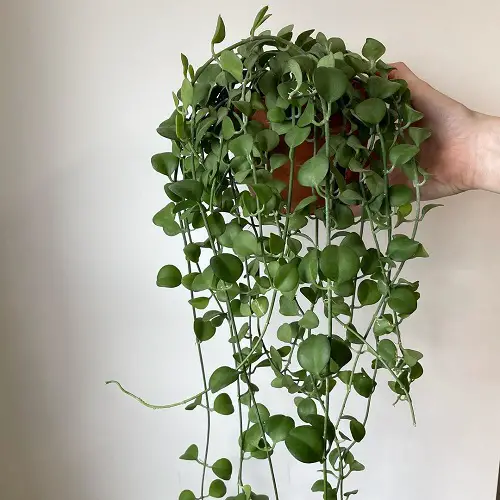Dischidia Geri is an evergreen specimen and looks fantastic in pots with its trailing stems. Let’s have a look at how to grow it!
Dischidia Geri is a beautiful epiphytic plant that can thrive in a variety of indoor environments. The best part is that it looks great in pots!
Botanical Name: Dischidia ‘Geri’
Learn How to Grow Dischidia Nummularia
Dischidia Geri Information
Dischidia Geri is a tropical, evergreen, vine-like plant native to the tropical rainforests of Southeast Asia. It is a member of the Apocynaceae family and is related to the Hoya plant.
The plant has dark green, oval-shaped leaves and produces small, white flowers. It is an easy plant to care for and can be grown indoors or in a bright, shaded spot in a garden.
Propagating Dischidia Geri
Propagating Dischidia Geri plants is a relatively straightforward process. You can propagate the plant by stem cuttings and by air layering.
- For stem cuttings, take a healthy stem from the parent plant and use a sharp knife to cut it just below a node. Remove the leaves from the lower half of the cutting, and dip the cut end in the rooting hormone. Plant the cutting in a pot filled with moist, well-draining soil. Place the pot in a warm, shaded area and water the soil regularly. Once the cutting has developed roots, you can transplant it into a larger pot.
- For air layering, select a healthy stem from the parent plant. Make a small cut in the stem and insert a small piece of moist sphagnum moss. Wrap the moss with plastic wrap or aluminum foil and secure it in place. Place the stem in a warm, shaded area and water the soil regularly. Once the roots have developed, remove the plastic wrap or aluminum foil and cut the stem just below the roots. Plant the rooted stem in a pot filled with moist, well-draining soil.
Learn How to Grow Dischidia ovata
Requirements for Growing Dischidia Geri
Light
Dischidia Geri prefers bright but indirect light. Too much direct sun can burn the leaves, while too little light can cause the plant to become leggy and lose its shape.
It is recommended to place the plant near a window that receives filtered light or in a shaded outdoor area.
Soil
For Dischidia Geri, the best potting mix is a well-draining, light, and airy mix. This can be created by combining equal parts of potting soil, perlite, and coarse sand.
Additionally, you can add some peat moss and coconut coir to increase its water-holding capacity. This mix should be light, airy, and have excellent drainage.
Water
During the growing season, water regularly to keep the soil lightly moist but not soggy. Allow the top inch of soil to dry out before watering, and reduce watering during the winter months. Mist the leaves regularly, especially during dry periods.
Humidity
Dischidia Geri plants prefer to be grown in a humid environment. They should be kept in an environment with high humidity levels of 60-80%.
During the summer months, the humidity levels should be increased by misting the leaves. It is also beneficial to place the plant on a humidity tray or near a humidifier to help keep the air around the plant humid.
Read about Dischidia hirsuta ‘Red Leaf’ Care
Dischidia Geri Care

Fertilizer
A balanced fertilizer, such as a 20-20-20, applied at half strength once every two weeks during the growing season (spring through fall), will help keep your Dischidia Geri healthy and growing.
Pests and Diseases
Dischidia Geri plant is resistant to most common pests and diseases. However, it is still subject to attack by aphids, mealybugs, and scale insects. These pests can be treated with insecticidal soap or horticultural oil.
The plant may also be susceptible to root rot caused by overwatering or poor drainage. To prevent this, it is important to keep the soil consistently moist but not soggy.
Another major threat to Dischidias is Powdery Mildew and Southern Blight, which can occur when excess moisture sits on compacted foliage. If this happens, remove the affected areas and improve growing conditions by placing the plant in a brighter location and keeping the leaves dry.




